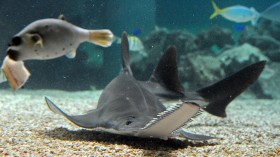A flying saucer landed with an enormous splash in the Pacific Ocean last weekend, but be assured that aliens haven't come to make first contact. NASA's saucer-like Supersonic Flight Dynamics Test Vehicle flew for the first time on Saturday, not only successfully reaching proper heights, but additionally testing technology way ahead of schedule.
The test vehicle was flown as part of the agency's Low-Density Supersonic Decelerator (LDSD) Mission, where a balloon took the vehicle up to about 120,000 feet above the coast of the US Navy's Pacific Missile Range Facility in Kauai, Hawaii. Then, a propulsion rocket kicked in, pushing the craft an additional 60,000 feet into the air - only to plummet back to the ocean from near-space.
"We are thrilled about yesterday's test," Mark Adler, project manager for LDSD at NASA's Jet Propulsion Laboratory (JPL) in Pasadena, Cali., said in a statement. "The test vehicle worked beautifully, and we met all of our flight objectives. We have recovered all the vehicle hardware and data recorders and will be able to apply all of the lessons learned from this information to our future flights."
What's more, this first of three LDSD flights went so well that engineers were able to test additional technologies.
"Because our vehicle flew so well, we had the chance to earn 'extra credit' points with the Supersonic Inflatable Aerodynamic Decelerator [SIAD]," said Ian Clark, principal investigator for LDSD at JPL. "All indications are that the SIAD deployed flawlessly, and because of that, we got the opportunity to test the second technology, the enormous supersonic parachute, which is almost a year ahead of schedule."
Real-time imagery showed that the experimental Supersonic Disk Sail Parachute (SDSP) did not deploy exactly as intended, providing engineers and specialists insight into making adjustments before the next LDSD test.
The LDSD was designed to test several landing apparatus for future heavy-payload Mars landings, simulating landing conditions as best they can on Earth.
[Credit: NASA/ Ian Clark]
© 2024 NatureWorldNews.com All rights reserved. Do not reproduce without permission.
![Severe Thunderstorm Alert: Tornadoes, Damaging Winds and Hail Possible from Upper Ohio Valley to Northeast US [NWS]](https://1471793142.rsc.cdn77.org/data/thumbs/full/70161/280/157/50/40/severe-thunderstorm-alert-tornadoes-damaging-winds-and-hail-possible-from-upper-ohio-valley-to-northeast-us-nws.jpg)




